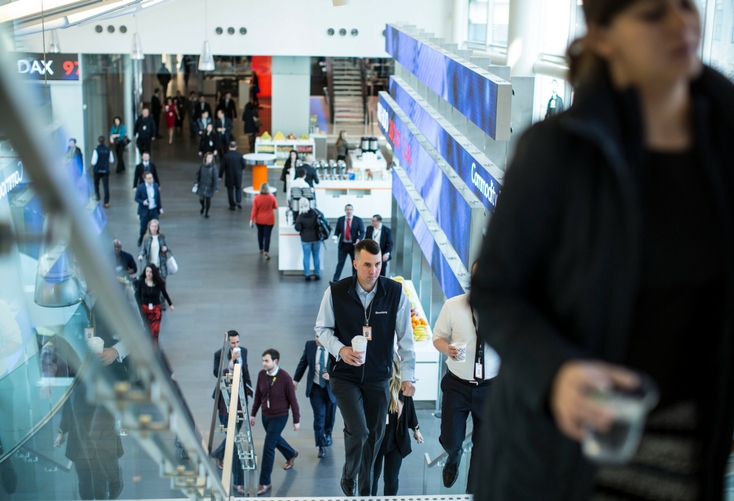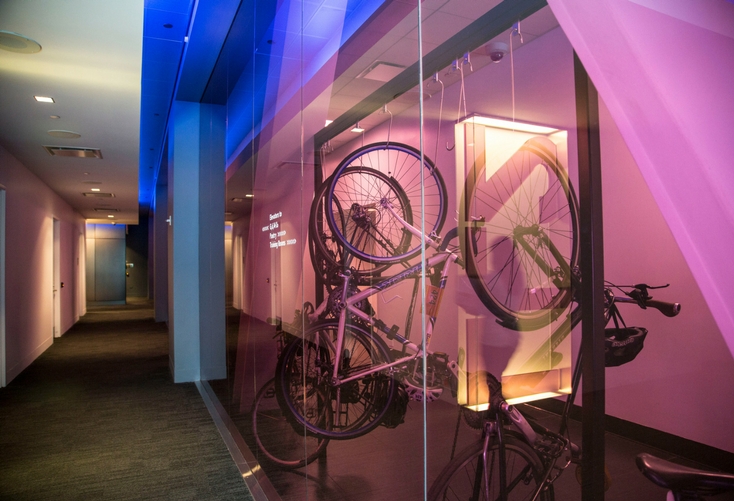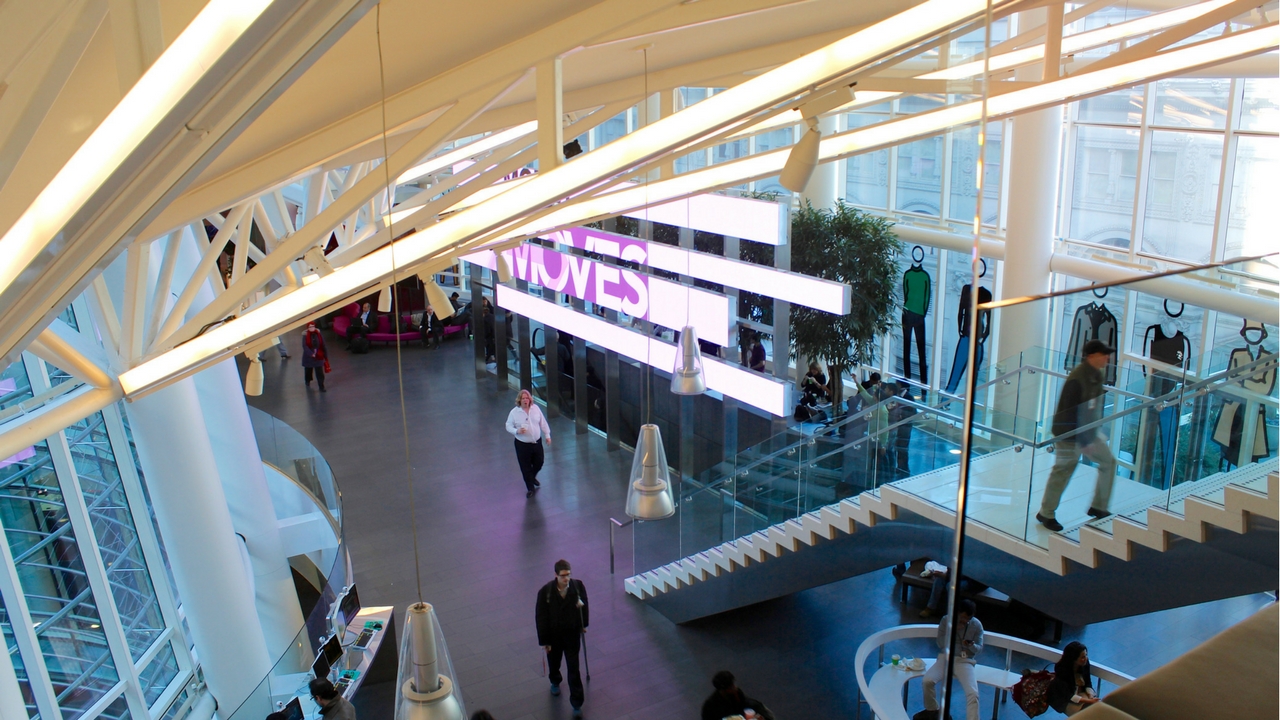- Bloomberg’s HQ in New York recently received a 3 star Fitwel certification
- Bloomberg Tower is the first building to pursue the Fitwel certification jointly by a landlord and tenant
- Active design has always been a core element of Bloomberg’s workplace strategy; Fitwel brings credibility to their efforts
Recently, Bloomberg announced that its New York headquarters had received the highest 3 star Fitwel certification from the Center for Active Design. Created by the Center for Disease Control and Prevention (CDC) and the General Services Administration (GSA), Fitwel is a high-impact certification system that optimizes buildings so that they support individual and community health.
Though the certification system was launched a few years ago, it wasn’t made available to the general public until early 2017, shortly after the Center for Active Design was awarded with an operating license. Today the certification is available for both public and private companies and it can be pursued by residential, as well as commercial buildings.
The certification, which was awarded to Bloomberg’s offices in the 731 Lexington Avenue Building, commonly known as Bloomberg Tower, was jointly pursued by Bloomberg and Vornado Realty Trust, the building’s owner.

Allwork.Space spoke with Michael Barry, Head of Sustainable Business Operations at Bloomberg L.P., and Joanna Frank, President and CEO of the Center for Active Design (CfAD), to learn about Bloomberg’s holistic workplace strategy, the Fitwel certification process, and why Fitwel was a natural fit for Bloomberg.
Barry explains that “active design has been part of the company’s culture since it was founded.” Bloomberg offices were designed so that if employees need to talk with one another, they do it in person as opposed to sending an email. “Our offices foster verbal communication among teams, they encourage people to move, creating opportunities for numerous encounters with colleagues from across the office.”
“We have visible stairways; we actually built them in the middle of each floor so that people have easy access to move between floors. Additionally, our elevators don’t stop on every floor, which encourages people to take the stairs, fostering physical activity throughout the day.”
Throughout the 900,000 square feet of office space, Bloomberg has several pantry areas, which offer employees a selection of healthy foods. “Our pantries are gathering areas, and they’re located on specific floors, which means that people must stand up, walk around, and take the stairs to get there.”
Both mobility and food are workplace strategies that the Fitwel certification awards points to. Frank, President of CfAD, explains that Fitwel doesn’t just look at the food itself, “one must also address the way you offer the food, how it’s presented, the size of the plates, and even what you offer in vending machines.”
As for mobility within the space, Frank mentions that they look into the opportunities that the space offers for people to “stand, walk around, and work; we look at the different options companies offer for people to get different types of work done, also taking into consideration whether people can see outside and see nature.”

The Fitwel certification was developed after analyzing thousands of research studies, where experts measured the impact of design on various aspects of health. “The way that the system works is that each strategy awards a certain number of points; the points are a direct reflection of the body of evidence available on the impact each strategy has on health. There is an algorithm in the system that calculates this.”
The 3 star rating is Fitwel’s highest rating, only 13 companies–including Bloomberg–have it, and according to Frank it’s not easy to get.
“To obtain this level of rating requires a very comprehensive approach to workplace design, everything from building design, location, cleaning products, and management is considered.” Working together with the building manager, Vornado Realty Trust, was key to Bloomberg’s success in securing the 3 star rating.
According to Barry, Bloomberg already had in place most of the strategies that Fitwel asks for. For example, Frank explains that the highest rating strategy requires a lactation room inside the building, as the body of evidence suggests that it has a high impact on mental, physical, and community health.
“We have lactation rooms in the offices; we also have bike parking, quiet rooms, a green purchasing policy, and everyone has access to daylight and outdoor views,” says Barry. The tower’s physical location also played an important role, as neighborhood walkability scores are considered when evaluating a building.

Speaking about the process, Barry mentions that the challenge for Bloomberg and Vornado was mostly about getting all of the necessary documentation together. “Other than that, Fitwel is a very hands-on process and it’s not rigid. One of the reasons we chose Fitwel as opposed to other wellness certifications is that a this is a great certification to incorporate into an existing property,” Barry said.
On the same note, Frank adds that “there are no prerequisites to Fitwel, so anyone can apply.” And while she encourages landlord and tenant cooperation, like the one between Bloomberg and Vornado, it’s not necessary in order to get certified. “We have different certifications, depending on whether you are a tenant or landlord; the certification is customizable depending on what you have control of.”
Closing off the interview, Barry mentions that for Bloomberg, “the certification is a a recognition of our leadership and commitment to active design, and because it’s a third-party certification it adds transparency to our efforts.”
There are currently 380 buildings certified and in the process of being certified by Fitwel, in the United States and abroad. The certification is valid for 3 years, after which buildings must go through a recertification process.


 Dr. Gleb Tsipursky – The Office Whisperer
Dr. Gleb Tsipursky – The Office Whisperer Nirit Cohen – WorkFutures
Nirit Cohen – WorkFutures Angela Howard – Culture Expert
Angela Howard – Culture Expert Drew Jones – Design & Innovation
Drew Jones – Design & Innovation Jonathan Price – CRE & Flex Expert
Jonathan Price – CRE & Flex Expert












